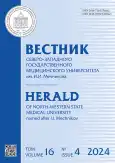Treatment of patients with periodontitis accompanied by halitosis with the use of bacterial drugs
- Authors: Kravets O.N.1, Alekseeva M.A.1, Kosolap P.D.1, Surdina E.D.1
-
Affiliations:
- North-Western State Medical University named after I.I. Mechnikov
- Issue: Vol 16, No 4 (2024)
- Pages: 111-117
- Section: Original study article
- URL: https://journal-vniispk.ru/vszgmu/article/view/276657
- DOI: https://doi.org/10.17816/mechnikov640867
- ID: 276657
Cite item
Abstract
BACKGROUND: Chronic generalized periodontitis is often accompanied by halitosis (ozostomy), which has a significant impact on the psycho-emotional state, social status of patients and reduces their quality of life. Synbiotic complexes are able to selectively affect the pathogenic microbiota, reducing her activity, thereby eliminating the phenomena of ozostomy.
AIM: To evaluate the effectiveness of a synbiotic complex based on the lysate of Streptococcus thermophilus in the treatment of mild chronic generalized periodontitis accompanied by halitosis.
MATERIALS AND METHODS: 30 patients with chronic generalized periodontitis of mild severity and phenomena of halitosis were examined. The periodontal status was determined using Plaque Index, Papillary-marginal-alveolar Index, Sulcus Bleeding Index, and measuring the depth of periodontal pockets. The level of halitosis was determined by the method of organoleptic assessment of oral odor according to R. Seemann, a test with a floss and a napkin, a psychophysical assessment of odor according to the M. Rosenberg scale, the assessment of plaque on the tongue using the Winkel Tongue Coating Index. In the main group, complex treatment was performed with the inclusion of a synbiotic complex based on the lysate of Streptococcus thermophilus. The control group of the patients did not receive the synbiotic complex.
RESULTS: After the therapy, both groups showed an improvement in the condition of periodontal tissues, a decrease in the level of halitosis in the patients and a statistically significant change in the main clinical parameters studied. Moreover, in the patients of the main group, 3 months after the start of therapy, the degree of ozostomy was 2.8 times lower than in the control group.
CONCLUSIONS: The use of a synbiotic complex based on the lysate of the culture of Streptococcus thermophilus in the treatment of chronic generalized periodontitis of mild severity, accompanied by halitosis, increases the effectiveness of traditional therapy.
Full Text
##article.viewOnOriginalSite##About the authors
Olga N. Kravets
North-Western State Medical University named after I.I. Mechnikov
Author for correspondence.
Email: Olga.Kravetc@szgmu.ru
ORCID iD: 0009-0008-3252-0605
SPIN-code: 4278-7900
MD, Cand. Sci. (Medicine)
Russian Federation, Saint PetersburgMaria A. Alekseeva
North-Western State Medical University named after I.I. Mechnikov
Email: mashaalekseeva0510@yandex.ru
ORCID iD: 0009-0008-5223-1958
Russian Federation, Saint Petersburg
Polina D. Kosolap
North-Western State Medical University named after I.I. Mechnikov
Email: kpd1036@gmail.ru
ORCID iD: 0009-0003-6917-3970
Russian Federation, Saint Petersburg
Elina D. Surdina
North-Western State Medical University named after I.I. Mechnikov
Email: Elina.Surdina@szgmu.ru
ORCID iD: 0000-0002-3018-8513
SPIN-code: 2296-0405
MD, Cand. Sci. (Medicine), Associate Professor
Russian Federation, Saint PetersburgReferences
- Nazir MA. Prevalence of periodontal disease, its association with systemic diseases and prevention. Int J Health Sci (Qassim). 2017;11(2):72–80.
- De Geest S, Laleman I, Teughels W, et al. Periodontal diseases as a source of halitosis: a review of the evidence and treatment approaches for dentists and dental hygienists. Periodontol 2000. 2016;71(1):213–227. doi: 10.1111/prd.12111
- Tsai C, Chou HH, Wu TL, et al. The levels of volatile sulfur compounds in mouth air from patients with chronic periodontitis. J Periodontal Res. 2007;43(2):186–193. doi: 10.1111/j.1600-0765.2007.01011.x
- Vandekerckhove B, van Steenberghe D. The role of periodontal diseases in bad breath. Ned Tijdschr Tandheelkd. 2002;109(11):430–433. (In Dutch)
- Hitrov VY, Zabolotnyj AI. Halitos – a medical and social problem. Practical Medicine. 2009;(33):12–17. (In Russ.) EDN: OZAHYJ
- Rosenberg M. The science of bad breath. Sci Am. 2002;286(4):72–79. doi: 10.1038/scientificamerican0402-72
- Tsarev V, Dikinova B, Revazova Z, Ippolitov E. Evaluation of pathogenic microbiota of periodontal pockets when using a probiotic complex for treating periodontitis accompanied by halitosis. Parodontologiya. 2017;22(3(84)):42–46. (In Russ.) EDN: ZHVEUH
- Krespi YP, Shrime MG, Kacker A. The relationship between oral malodor and volatile sulfur compound-producing bacteria. Otolaryngol Head Neck Surg. 2006;135(5):671–676. doi: 10.1016/j.otohns.2005.09.036
- Ippolitov EV. Monitoring the formation of microbial biofilm and optimization of diagnostics of inflammatory periodontal diseases [dissertation]. Available from: https://www.sechenov.ru/upload/medialibrary/414/dissertatsiya_ippolitov_itog.pdf. (In Russ.) EDN: ZQBNMR
- Söder B, Johansson B, Söder PO. The relation between foetor ex ore, oral hygiene and periodontal disease. Swed Dent J. 2000;24(3):73–82.
- Ademovski SE, Persson GR, Winkel E, et al. The short-term treatment effects on the microbiota at the dorsum of the tongue in intra-oral halitosis patients – a randomized clinical trial. Clin Oral Investig. 2013;17(2):463–473. doi: 10.1007/s00784-012-0728-y
- Galonskii VG, Tarasova NV, Shushakova AA, et al. Halitosis: modern diagnostics, prevention and treatment. Siberian medical review. 2011;71(5):9–13. (In Russ.) EDN: OIRWAD
- Kumbargere Nagraj S, Eachempati P, Uma E, et al. Interventions for managing halitosis. Cochrane Database Syst Rev. 2019;12(12):CD012213. doi: 10.1002/14651858.CD012213.pub2
- Anusha RL, Umar D, Basheer B, Baroudi K. The magic of magic bugs in oral cavity: Probiotics. J Adv Pharm Technol Res. 2015;6(2):43–47. doi: 10.4103/2231-4040.154526
- Hill C, Guarner F, Reid G, et al. Expert consensus document. The International Scientific Association for Probiotics and Prebiotics consensus statement on the scope and appropriate use of the term probiotic. Nat Rev Gastroenterol Hepatol. 2014;11(8):506–514. doi: 10.1038/nrgastro.2014.66
- de Vrese M, Schrezenmeir J. Probiotics, prebiotics, and synbiotics. Adv Biochem Eng Biotechnol. 2008;111:1–66. doi: 10.1007/10_2008_097
- Roberfroid M, Gibson GR, Hoyles L, et al. Prebiotic effects: metabolic and health benefits. Br J Nutr. 2010;104(Suppl 2):S1–S63. doi: 10.1017/S0007114510003363
- Sharma R, Bhaskar BS, Sanodiya BS, et al. Probiotic efficacy and potential of Streptococcus thermophilus modulating human health: a synoptic review. IOSR J Pharm Biol Sci. 2014;9(3):52–58. doi: 10.9790/3008-09325258
- Ursova NI. Therapeutic potential of modern probiotics. Pediatric pharmacology. 2013;10(2):46–56. EDN: PZSUIN doi: 10.15690/pf.v10i2.644
- Lee SH, Baek DH. Effects of Streptococcus thermophilus on volatile sulfur compounds produced by Porphyromonas gingivalis. Arch Oral Biol. 2014;59(11):1205–1210. doi: 10.1016/j.archoralbio.2014.07.006
- Rosenberg M, Kulkarni GV, Bosy A, McCulloch CA. Reproducibility and sensitivity of oral malodor measurements with a portable sulphide monitor. J Dent Res. 1991;70(11):1436–1440. doi: 10.1177/00220345910700110801
Supplementary files







